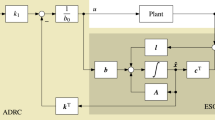Abstract
An efficient critical control system design is proposed in this paper. The key idea is to decompose the design problem into two simpler design steps by the technique used in the classical loop transfer recovery method (LTR). The disturbance cancellation integral controller is used as a basic controller. Since the standard loop transfer recovery method cannot be applied to the disturbance cancellation controller, the nonstandard version recently found is used for the decomposition. Exogenous inputs with constraints both on the amplitude and rate of change are considered. The majorant approach is taken to obtain the analytical sufficient matching conditions. A numerical design example is presented to illustrate the effectiveness of the proposed design.
Similar content being viewed by others
References
V. Zakian. New formulation for the method of inequalities. Proceedings of the Institution of Electrical Engineers, vol. 126, no. 6, pp. 579–584, 1979.
V. Zakian. A Framework for Design: Theory of Majorants. Control Systems Centre Report, 604, University of Manchester Institute of Science and Technology, Manchester, UK, 1984.
V. Zakian. Critical systems and tolerable inputs. International Journal of Control, vol. 49, no. 4, pp. 1285–1289, 1989.
V. Zakian. Well matched systems. IMA Journal of Mathematical Control and Information, vol. 8, no. 1 pp. 29–38, 1991.
V. Zakian. Perspectives on the principle of matching and the method of inequalities. International Journal of Control, vol. 65, no. 1, pp. 147–175, 1996.
V. Zakian. Control Systems Design: A New Framework, Berlin, Germany: Springer, 2005.
V. Zakian, U. Al-Naib. Design of dynamical and control systems by the method of inequalities. Proceedings of IEE, vol. 120, no. 11, pp. 1421–1427, 1973.
T. Ishihara, T. Ono. Design of critical control systems for non-minimum phase plants via LTR technique. IEEJ Transactions on Electronics, Information and Systems, vol. 127, no. 5, pp. 733–740, 2007.
G. Stein, M. Athans. The LQG/LTR procedure for multivariable feedback control design. IEEE Transactions on Automatic Control, vol. 32, no. 2, pp. 105–114, 1987.
A. Saberi, B. M. Chen, P. Sannuti. Loop Transfer Recovery: Analysis and Design, New York, USA: Springer-Verlag, 1993.
E. J. Davison, I. J. Ferguson. The design of controllers for the multivariable robust servomechanism problem using parameter optimization methods. IEEE Transactions on Automatic Control, vol. 26, no. 1, pp. 93–110, 1981.
B. D. O. Anderson, J. B. Moore. Optimal Control: Linear Quadratic Methods, New Jersey, USA: Prentice Hall, 1990.
G. F. Franklin, J. D. Powell, A. Emami-Naeini. Feedback Control of Dynamic Systems, 2nd ed., USA: Addison-Wesley, 1993.
H. J. Guo, T. Ishihara, H. Takeda. Design of discrete-time servo systems using disturbance estimators via LTR technique. Transactions of the Society of Instrument and Control Engineers, vol. 31, no. 5, pp. 646–652, 1996.
H. J. Guo, T. Ishihara, H. Takeda. LTR design of discretetime integral controllers based on disturbance cancellation. In Proceedings of IFAC 13th Triennial World Congress, pp. 295–300, 1996.
T. Ishihara, H. J. Guo, H. Takeda. Integral controller design based on disturbance cancellation: Partial LTR approach for non-minimum phase plants. Automatica, vol. 41, no. 12, pp. 2083–2089, 2005.
T. Ishihara, H. J. Guo. LTR design of integral controllers for time-delay plants using disturbance cancellation. International Journal of Control, vol. 81, no. 2, pp. 1027–1034, 2008.
N. K. Rutland, P. G. Lane. Computing the 1-norm of the impulse response of linear time-invariant systems. Systems & Control Letters, vol. 26, no. 3, pp. 211–221, 1995.
J. F. Whidborne, G. P. Liu. Critical Control Systems: Theory, Design, and Applications, England: Research Studies Press, 1993.
W. Silpsrikul, S. Arunsawatwong. Computation of peak output for inputs restricted in and norms using finite difference schemes and convex optimization. International Journal of Automation and Computing, vol. 6, no. 1, pp. 7–13, 2009.
Author information
Authors and Affiliations
Corresponding author
Additional information
This work was supported by Grants-in-Aid for Scientific Research (No. 20560209).
Tadashi Ishihara received the Ph.D. degree in electrical engineering from Tohoku University, Sendai, Japan in 1979. From 1977 to 1987, he has been a research associate at the Department of Electrical Engineering, Tohoku University. Form 1987 to 1993, he has been an associate professor in the Department of Mechanical Engineering, Tohoku University. From 1993 to 2003, he has been an associate professor in Graduate School of Information Sciences, Tohoku University. Currently, he is a professor in the Faculty of Science and Technology, Fukushima University, Fukushima, Japan.
His research interests include robust control, stochastic adaptive control, and control system design based on the principle of matching.
Takahiko Ono received B.Eng. degree in mechanical engineering from Tohoku University, Japan in 1994 and M. Info. Sc. and Ph.D. degrees in information science from Tohoku University in 1996 and 1999, respectively. He has been a research associate at Tohoku University from 1999 to 2004. Currently, he is an associate professor at Graduate School of Information Sciences, Hiroshima City University, Japan.
His research interests include robust control, critical control, optimal filtering theory and analysis, and modelling of human reactions to acceleration in vehicle transportation.
Rights and permissions
About this article
Cite this article
Ishihara, T., Ono, T. Two-step design of critical control systems using disturbance cancellation integral controllers. Int. J. Autom. Comput. 8, 37–45 (2011). https://doi.org/10.1007/s11633-010-0552-2
Received:
Revised:
Published:
Issue Date:
DOI: https://doi.org/10.1007/s11633-010-0552-2




